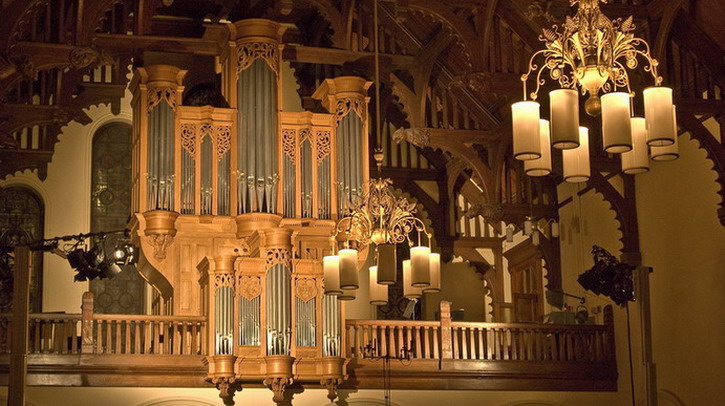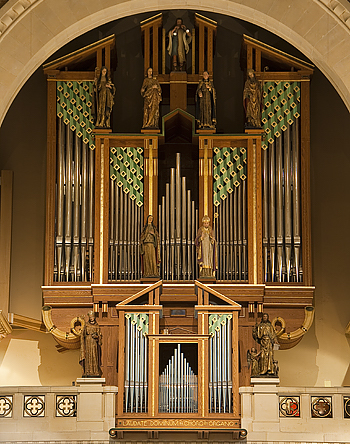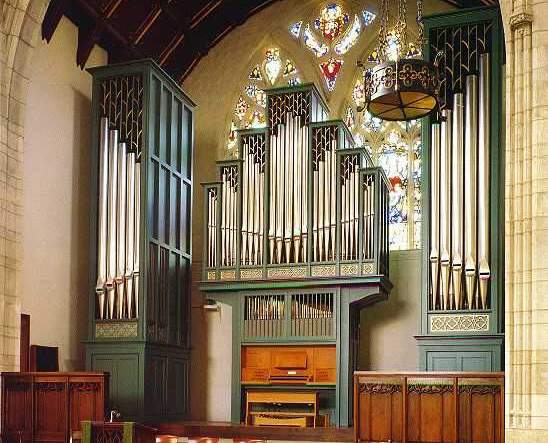


February 23, 2020
JOHN GREW
–––––––––––––––––––––––––––
French Classical Music in Canada

February 23, 2020
JOHN GREW
–––––––––––––––––––––––––––
French Classical Music in Canada

The 1981 Hellmuth Wolff organ at McGill University in Montréal, Canada.
The 1981 Hellmuth Wolff organ at McGill University in Montréal, Canada.
Introduction
John Grew discusses French Classical performance practice and Canadian organ culture in this interview with Vox Humana Associate Editor Nicholas Capozzoli.
––––––––––––––––––––––––
Professor Grew, thank you for agreeing to this interview. Many organists are eager to hear a bit about you and your thoughts on one of your most well-known specialties: the French Classical organ repertoire. First, how did you develop a passion for this music?
Well, I think it’s in my genes! Grew (formerly Grue) is a French Norman name. In fact, when I first travelled to Normandy, I had a strong atavistic feeling I had been there before. The earth smelled the way I thought it would, and something just clicked within me. I’ve enjoyed touring the Norman countryside ever since. I think this fostered a passion for French music and art. As a teen, I loved playing the piano music of Debussy, and I often accompanied mélodies of Fauré and Duparc. I’m also inspired by French art. I love Monet and the French Impressionists, but whenever I’m at the Louvre, I head for the seventeenth-century stuff. This visual fascination, along with the special sound of French music, led me to discover François Couperin. Back in the day, we played his music on the piano (remember that the first edition of Couperin’s keyboard music was made by Johannes Brahms). It’s not totally crazy to do — there’s a melancholy in Couperin’s music not unlike the melancholy of Chopin. I had many early recordings that I wore out as a teenager, but I especially loved the Passacaille from Couperin’s eighth ordre. I owned a terrible recording of a horrible Neupert harpischord, but the music still worked. As far as organ recordings, I think the most remarkable one was Melville Smith’s LP of Nicolas de Grigny’s Livre d’orgue on the Johann Andreas Silbermann organ in Marmoutier. I immediately fell in love with the beauty and poetry of French organ music.
I’m fortunate to have had many wonderful teachers with whom I could study this music. During the summers of my graduate studies, I travelled to Montréal to study organ with Raymond Daveluy and harpsichord with Kenneth Gilbert. I attended several Haarlem and Pistoia academies where I met people like Gustav Leonhardt, Anton Heiller, and Luigi Tagliavini. Thanks to a Canada Council grant, I had an intensive year in Paris with Marie-Claire Alain. I especially loved following her around to pull stops at her concerts. The best part was when she had her afternoon nap, and I was left to play the organ! Perhaps the most remarkable experience was assisting her at the Clicquot organ in Poitiers for one of her Couperin recordings.
I should also point out two very important books that were influential during my studies: Fenner Douglass’s The Language of the French Classical Organ and Peter Williams’s The European Organ. These were groundbreaking back in the 1960s. Together with my studies, these authors opened up a whole new world for me.
From your experience playing period instruments (as well as modern reconstructions in Montréal), what do French Classical organs tell us about how to play this music?
I think the discovery of old instruments was one of the most fascinating outcomes of the early music revival in the 1950s and 60s. However, it was the source of much confusion and many misunderstandings. Organbuilders used to advertise, “Our pipes have more chiff!” Well, anyone who has played an old organ (whether it’s French, German, Italian, or Spanish) knows that they don’t clunk, spit, or make ugly sounds — they sing. Similar problems were found in the harpsichord world of the 50s and 60s when metal frame instruments were dominant. People even used to put thumb tacks in the hammers of pianos to sound like a harpsichord — of course, it had nothing to do with what a real harpsichord sounded like! This bred a lot of misconceptions about sound, and it took a long time for people understand how to play this music. Once they did, there was a whole new approach to touch, articulation, and ornamentation. Players returned to original sources, reading prefaces and treatises to understand how people back then envisioned this music. I still think it’s important for students to read the writings of C.P.E. Bach, Quantz, and for French music, François Couperin’s L’art de toucher le clavecin.
The French were prized throughout Europe for their instrument building, especially the mechanical aspect. Old French organs have a very responsive action, even with all keyboards coupled. This allows for a fluid and easy execution of ornaments. We find this also in German organs; after all, Gottfried Silbermann worked with the French builder Jean de Joyeuse. The Silbermann tradition is a synthesis of French influences, just as the music of J.S. Bach has many French elements. Think of Nun komm, der Heiden Heiland from the Orgebüchlein — the style brisé — it can’t be played like a series of hiccups. If you followed the rules of articulation that were rampant in the 50s and 60s, you had to detach every note before every beat. That was the way it “had” to be done. I call it “false articulation” because it doesn’t correspond to anything historical... thankfully, Peter Williams has put that to rest!

In the 60s and 70s, North Americans didn’t have reference instruments for this music. If you’re in Europe, you can walk down the street and play an old organ. We didn’t have this luxury, and so we had to build historical copies. Thanks to the early work of builders like C.B. Fisk and John Brombaugh, North American building is now highly informed of old instruments and their sound. In Montréal, we are fortunate to have two instruments inspired by the French Classical tradition: the Wolff organ in McGill University’s Redpath Hall and a Guilbault-Thérien in the Grande Séminaire. While they are not exactly like a Clicquot, the specifications get us close to the French sound world. Organists can use the registrations specified by the early writers without all the compromises we often have to make on other instruments.

This repertoire is inherently wedded to organs of specific design and unique timbres. Since nearly all organists don’t have regular access to, say, a Clicquot organ, how can we approach French Classical music on typical instruments in North America?
I think the most important aspect is getting a good sound from the instrument. Organists are always trying to imitate, but you should always know what you want to imitate. This is why it’s important to play old instruments — they open up a whole new world of sound and make you think. A thoughtful player who has the references of historic organs can make any bad organ sound better than it is. If you have a Nazard, Tierce, and good reeds, you can make this music work on any organ (mechanical or electric). Even if you only have one Nazard and Tierce on the Swell, you can couple it to the Great and still play any duo. I think the French Classical repertoire is much more adaptable than that of, say, Frescobaldi. I don’t think it’s esoteric at all.

For most of my career I played an instrument that wasn’t particularly suited to this repertoire, but I always made it work. I was organist at Queen Mary Road United Church in Montréal from 1967 until the church’s closure in 1991. It had the first Beckerath organ in Canada, not to mention the first modern mechanical-action instrument in any Canadian church. I played this repertoire there all the time, but I had to be creative. I didn’t have a 16’ Bourdon, so I would play the 8’ and 4’ flutes down an octave for the accompaniment in a tierce en taille. Any organist can do tricks like this to get the appropriate sound out of an instrument.

Having lived and taught in Montréal for over 40 years, you have left an impressive legacy on the city’s organ culture. One of your major achievements was establishing the McGill Summer Organ Academy. Tell us more about this.
During my sabbatical year in 1996, I wanted to organize an academy for advanced players to work with the world’s leading experts. Essentially, I wanted to bring the Haarlem academy to Montréal. I knew programs like these were expensive for students, and so my doctor friend (who funded the organ in Redpath Hall) gave me the seed money for this project. These academies were crucial to my development, and I wanted the next generation to have the same opportunities.
The first academy took place in 1997, and we hosted one every two years for the next 20 years. They were two weeks of intensive study, masterclasses, and concerts. At the outset, we had professors like Olivier Latry for French Romantic, Bernard Lagacé for Bach, and James David Christie for North German Baroque. Over the years, I invited colleagues such as Marie-Claire Alain, Luigi Tagliavini, Christopher Stembridge, Ludger Lohmann, Hans-Ola Ericsson, and Carole Terry. These academies also inspired people interested in new music, particularly those who made new sounds with the old instruments. In fact, the composer William Albright joined us for our first academy and taught contemporary music classes. Once I stepped down from McGill, we realized times had changed and that there were plenty of other opportunities like this in North America. Nevertheless, these academies were great fun and brought students from all over the world to Montréal.
Montréal is not only an ideal city to study the organ, but also to compete. In 2008, you established the Canadian International Organ Competition, the biggest competition of its kind in the Western hemisphere. How did that come about, and what do you hope it can offer young organists in comparison to other competitions?
I served on the jury of the last Calgary International Organ Competition in 2002, and I knew I wanted to continue it in Montréal. The city is a natural fit for something like this–we have great instruments, an appreciation for early music, and (most importantly) a public for organ recitals. For two years, I searched for people to support the concept, advertise it, and fund it. I managed to get a board of directors with Noël Spinelli as chair and René Fréchette as executive director. We wanted October to be the organ month in Montréal; too much goes on in the spring, and so during this month we host a triennial competition as well as an annual festival. The most important aspect of this competition for me is to help young players launch their careers. We want them to concertize and bring the instrument to the public. Our awards in the form of prize money and a CD recording encourage them to do so.
I served on a lot of juries in my career, and I learned how to run (and how not to run) a competition. We have a jury of nine international organists, which I think is a good number to have. From day one, I wanted to make sure the competitors are visible. Organists are often hidden away in lofts, and it’s important for the public to have this visual connection with the player. Competitors play about three hours of music split up into three rounds. The repertoire is largely open, although there are some restrictions in each round. The first round consists mostly of Bach — I’ve always said that if you can’t play Bach, you’re not an organist! The second and third rounds determine if the competitor can build a program that works with an audience. Of course, the jury is looking for artists who have technique and knowledge of different styles, but most important is finding an artist who connects with the larger public. Our most recent First Prize winner, Alcée Chriss III, draws on his expertise in jazz to reach a whole new audience.
The first competition took place in 2008, and every three years, the organization get stronger and the playing quality is higher. Thanks to the efforts of our new director Thomas Leslie and my successor Jean-Willy Kunz, the CIOC breathes new life into the organ world. They have great ideas about how to make this festival more exciting and relevant to today’s audiences. Above all, the more we can help young organists launch their careers, the better.
––––––––––––––––––––––––
The views and opinions expressed in this article are those of the author, and do not necessarily reflect the position of Vox Humana.